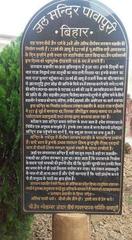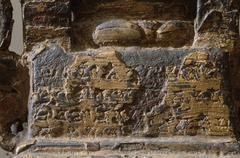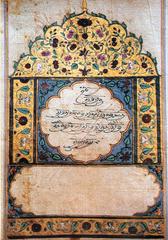Indrapuri Barrage, Bihar, India: Visiting Hours, Tickets, and Travel Guide
Date: 04/07/2025
Introduction
The Indrapuri Barrage, a monumental feat of mid-20th-century engineering, spans the Sone River in Bihar, India. Renowned for its scale and strategic importance, the barrage has played a transformative role in irrigation, flood control, and socio-economic development across Bihar and eastern Uttar Pradesh. Beyond its utilitarian purpose, Indrapuri Barrage is a vibrant cultural landmark and a scenic destination, drawing tourists, history enthusiasts, and nature lovers alike. With ongoing investments and future developments planned, it stands poised to further enhance its stature as one of Bihar’s most significant tourist and community sites.
This guide provides comprehensive, up-to-date information for prospective visitors, covering visiting hours, ticket details, access routes, nearby attractions, cultural and historical context, and practical travel tips, ensuring an enriching experience at Indrapuri Barrage.
Table of Contents
- Introduction
- Historical and Cultural Significance
- Visitor Information
- Visitor Experience
- Economic, Agricultural, and Strategic Importance
- Community Benefits and Local Development
- Safety, Security, and Environmental Management
- Enhancing the Visitor Experience: Recommendations
- Frequently Asked Questions (FAQ)
- Conclusion and Recommendations
- Reliable Sources and Further Reading
Historical and Cultural Significance
Engineering Heritage and Impact
Commissioned in 1968 and constructed by Hindustan Construction Company, Indrapuri Barrage stretches 1,407 meters (4,616 feet), ranking among the world’s longest barrages (Wikipedia; Rohtas District). The barrage succeeded the 19th-century Dehri anicut, expanding Bihar’s irrigation network and transforming previously unproductive lands into fertile agricultural zones. Its extensive system of main, branch, and distributary canals underpins local agriculture and sustains rural livelihoods.
Socio-Economic and Cultural Role
More than a water management structure, Indrapuri Barrage is a cherished community gathering place and a symbol of Bihar’s progress. During festivals like Chhath Puja, thousands gather along the Sone River’s banks to perform rituals, with the barrage area serving as a focal point for community celebrations (Bihar Tourism). Its tranquil environment makes it a popular spot for picnics, recreation, and cultural events.
Local artisans and musicians often celebrate the barrage in murals and folk songs, reflecting its deep-rooted presence in regional identity. Enhanced irrigation has diversified agriculture and enriched local cuisine, making the area’s markets and fairs lively attractions for visitors.
Visitor Information
Visiting Hours and Ticket Details
- Opening Hours: Daily, from 6:00 AM to 6:00 PM. Visiting during early morning or late afternoon is recommended for optimal weather and scenic views.
- Entry Fee: None. Entry to Indrapuri Barrage is free for all visitors.
- Guided Tours: While there are currently no formal guided tours, local guides and community organizations may offer tours and information upon request. Future tourism hub developments are expected to introduce structured tour options.
Accessibility and Facilities
- Location: Near Sasaram in Rohtas District, approximately 13 km from Dehri-on-Sone railway station.
- How to Get There:
- By Road: Well-maintained roads connect the barrage to Sasaram, Dehri-on-Sone, Patna, and Varanasi.
- By Train: The nearest major station is Dehri-on-Sone, with ample taxi and bus services to the barrage.
- By Air: The closest airport is in Patna, offering connections to major Indian cities.
- Facilities:
- Parking: Free parking is available.
- Restrooms and Water: Currently limited; visitors should carry their own water and plan accordingly (The Indian Feather).
- Food and Payments: Local vendors accept UPI and cash payments.
- Accessibility: No dedicated ramps or accessible restrooms at present; improvements planned under the upcoming tourism hub (Tourism Ministry Infrastructure Gap Assessment).
Planned Developments
A ₹25 crore investment is underway to develop a comprehensive tourism hub, which will feature modern amenities, food courts, enhanced infrastructure, handicraft stalls, and improved accessibility (Bihar Say).
Visitor Experience
Activities and Scenic Highlights
- Picnicking: The barrage is a popular spot for family outings and group gatherings, especially on weekends and holidays.
- Photography: Offers panoramic river views and lush landscapes, ideal for photography enthusiasts (The Indian Feather).
- Nature Walks and Birdwatching: The serene environment supports leisurely walks and birdwatching along the canals and riverbanks.
- Festivals and Culture: Experience vibrant celebrations during local festivals, with community performances and rituals along the river.
- River Activities: Some visitors enjoy bathing or sunbathing, but caution is advised due to strong currents and lack of lifeguards.
Nearby Attractions
- Dehri-on-Sone: Explore markets, eateries, and temples in this historic town.
- Rohtasgarh Fort: A major historical site, approximately 20 km from the barrage.
- Danwar Lake and Son River: Offer birdwatching, boat rides, and natural beauty (RailYatri).
Practical Travel Tips
- Best time to visit: November to March, when the weather ranges between 10–20°C.
- Essentials: Bring water, snacks, sun protection, and a first-aid kit.
- Dress modestly and respect local customs, especially during religious events.
- Check local sources or the Audiala app for updates on facilities and events.
Economic, Agricultural, and Strategic Importance
- Economic Impact: Central to regional growth, the barrage supports the Indrapuri Reservoir Scheme and a 3 x 100 MW hydropower project, bolstering energy security and reducing dependence on fossil fuels (Hydropower Industry News).
- Agriculture: Irrigates millions of hectares, enabling cultivation of rice, wheat, vegetables, and fruits, and stabilizing rural incomes (IJSRP Agriculture and Economy of Bihar).
- Flood Control and Water Management: Regulates river flow, reducing flood risk and enhancing drought resilience.
Community Benefits and Local Development
- Employment: Construction and maintenance of the barrage have provided jobs, stimulated local markets, and supported healthcare and education (Central Water Commission).
- Social Cohesion: Community water management initiatives have strengthened local governance and reduced migration.
- Tourism and Women’s Empowerment: Local entrepreneurship, especially among women’s self-help groups, is promoted through handicrafts and tourism services.
- Environmental Stewardship: Ongoing projects focus on afforestation, water quality, and biodiversity protection.
Safety, Security, and Environmental Management
- Safety: No formal water safety measures or lifeguards; visitors should exercise caution, especially during or after rains (Tourism Ministry Infrastructure Gap Assessment).
- Security: No dedicated tourist police or medical facilities; carry personal essentials and emergency contacts.
- Cleanliness: Garbage management needs improvement; visitors are encouraged to take back their waste. Enhanced waste management is planned under the new tourism hub.
Enhancing the Visitor Experience: Recommendations
- Install accessible toilets and drinking water stations.
- Provide ramps, tactile pathways, and multilingual signage.
- Develop guided tours and interpretive panels.
- Deploy seasonal lifeguards and first-aid stations.
- Promote local handicrafts and cultural events.
- Implement comprehensive waste management and eco-friendly tourism strategies (Bihar Say).
Frequently Asked Questions (FAQ)
Q: What are the visiting hours?
A: 6:00 AM to 6:00 PM daily.
Q: Is there an entry fee?
A: No, entry is free.
Q: Are guided tours available?
A: Not officially, but local guides may be available; formal tours are planned for the future.
Q: How accessible is the site for differently-abled visitors?
A: Currently limited, though significant improvements are planned.
Q: What are the best months to visit?
A: November to March, when weather is most pleasant.
Q: What attractions are nearby?
A: Dehri-on-Sone town, Rohtasgarh Fort, Danwar Lake, Son River.
Conclusion and Recommendations
Indrapuri Barrage is a remarkable confluence of engineering achievement, cultural vitality, and natural beauty. With free access, extensive visiting hours, and a host of activities and attractions, it is an ideal destination for families, students, and travelers seeking to experience Bihar’s heritage. Continued investments and upcoming developments promise to enhance visitor amenities, accessibility, and community benefits, further cementing the barrage’s role as a regional landmark.
Visitors are encouraged to plan trips during the cooler months, respect local customs, and contribute to environmental stewardship. For up-to-date information, facility updates, and travel tips, utilize resources such as the Audiala app and official tourism websites.
Reliable Sources and Further Reading
- Indrapuri Barrage: A Must-Visit Historical and Engineering Marvel in Bihar, 2025, Bihar Tourism (Bihar Tourism website)
- Visiting Indrapuri Barrage: Hours, Tickets, and Historical Significance in Bihar, 2025 (Hydropower Industry News)
- Indrapuri Barrage Visiting Hours, Tickets, and Tourist Guide to Bihar’s Historic Water Engineering Marvel, 2025 (The Indian Feather)
- Indrapuri Barrage: Visiting Hours, Tickets, and Exploring Dehri-on-Sone’s Historical Site, 2025 (Bihar Water Resources Department)
- Indrapuri Barrage Wikipedia, 2025 (Wikipedia)
- Rohtas District Official Website on Indrapuri Dam, 2025 (Rohtas District)
- Bihar Say: ₹25 Crore Tourism Hub Development, 2025 (Bihar Say)
- Tourism Ministry Infrastructure Gap Assessment, 2020 (Tourism Ministry Infrastructure Gap Assessment)
- RailYatri Guide to Dehri-on-Sone, 2025 (RailYatri)
- IJSRP Agriculture and Economy of Bihar, 2013 (IJSRP Agriculture and Economy of Bihar)


